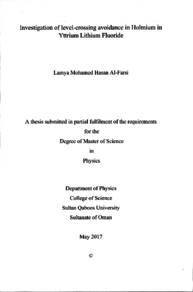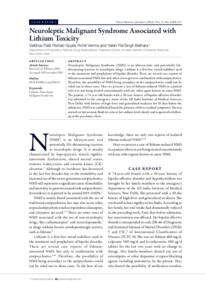Document
Investigation of level-crossing avoidance in holmium in yttium lithium fluoride
Publisher
Sultan Qaboos University
Gregorian
2017
Language
English
English abstract
In a quantum system, when a parameter of the Hamiltonian is varied, the energy levels evolve. Some energy levels may cross each other. At the point where the levels cross, there is an accidental degeneracy. Level crossing avoidance is a phenomenon that occurs when the system is subjected to a perturbation that has nonvanishing matrix elements between the two unperturbed states. In such situations, the two approaching states become linear combination of each other and evolve one into the other as the parameter of the Hamiltonian is varied. The crossing of the states occurs without the accidental degeneracy. It is said that the levels repel each other.
The present work is a study of the level crossing avoidance of some hyperfine levels of the holmium ion Ho3+ in Ho: YLi F4. The quantum system is the 4f shell of Ho3+ in the crystal field of the YLi F4 host. The varying parameter is an applied field and the perturbation is the hyperfine interaction. The total angular momentum J of Ho3+ is ] = 8 and the nuclear spin of 16S Ho is I = 7/2. The dimension of the combined nuclear-electronic Hamiltonian is therefore (2) + 1)*(21 + 1) = 136. For our study, we have used a program written in MATLAB® that construct and diagonalize this Hamiltonian. The electronic ground state of Ho3+ in Ho: YLi F4. is a doublet {\E.), \E,)} and the next state is a singlet \E2) at about 10 K. Each of the electronic levels is split into 8 hyperfine levels by the hyperfine interaction. As the ground doublet is split by the applied field, there are several crossings of the hyperfine levels.
Our investigation has shown that although the perturbing dipolar hyperfine interaction has no off-diagonal matrix elements between the two halves of the ground doublet {\E0), E1)} it unexpectedly causes level crossing avoidances. A refined analysis revealed that the large dipolar hyperfine interaction causes an admixture of the low-lying excited state \E2) into the ground doublet {\E.), E,)}. This admixture brings extra components to the ground doublet; these components have nonvanishing contributions to the off-diagonal matrix elements of the dipolar hyperfine interaction. Therefore, the dipolar interaction can cause the level crossing avoidance. The quadrupolar hyperfine interaction has off-diagonal matrix elements however, it is found that its contribution to the total off-diagonal matrix element is an order of magnitude smaller than the contribution due to the admixture of E2).
Member of
Resource URL
Arabic abstract
في النظام الكمي، عندما يتغير أحد معاملات مؤثر الطاقة (الهاميلتونيان) فإن ذلك يؤدي إلى انبثاق مستويات طاقة. بعض هذه المستويات قد تتقاطع. عند نقاط التقاطع لمستويات الطاقة هذه تحدث ظاهرة تعرف بتولد مستويات الطاقة العرضي. تحدث ظاهرة تفادي تقاطع المستويات عندما يتعرض النظام الكمي إلى تشويش بحيث لا توجد عناصر مصفوفة غير صفية بين مستويي الطاقة غير المشوشه. وفي هذه الحاله تصبح كل الحالتين الكميتين المتقاربتين تركيبا خطيا في الأخرى وينبثق كلاهما من الأخر عندتغير معامل المؤثر الهامیلتوني. عندها يتم تقاطع الحالات الكمية دون حدوث تولد الحالات الكم العرضي المذكور أعلاه. ويقال عند ذلك أن الحالات الكمية تتنافر.
في هذه الدراسة قمنا بالنظر إلى ظاهرة تفادي تقاطع المستويات بالنسبة إلى بعض مستويات التفاعل فائق الدقة في أيون الهولميوم في بلورة فلوريد الإيتريوم والليثيوم Ho3+ : LiYF . يعتبر النظام الكمي في هذه الحالة مكونا من الالكترونات الموجورة في القشرة ( مستوى الطاقة) 4f لأيون +Ho3 داخل الحقل (المجال البلوري المركب LiYF المعامل المتغير هو المجال المغناطيسي والتشويش هو التفاعل فائق الدقة. عدد كمية التحرك الزاوي الكلي للالكترون في أيون +Ho3 = 8 والعدد المغزلي النواة الهولميوم 165Ho = 7/ 2 . وعليه فان أبعاد المؤثر الهاميلتوني المشترك للالكترون والنواة تكون مساوية (1 + 2I) (1 + [2) = 136. تم استخدام برنامج المات لاب (°®
ATLAB) لبناء مصفوفة مؤثر الطاقة (الهامیلتوني) وجعلها قطرية حالة الطاقة M الالكترونية الأرضية لأيون +Ho3 في بلورة LiYF هي حالة مزدوجة {( E) ,
في هذه الدراسة قمنا بالنظر إلى ظاهرة تفادي تقاطع المستويات بالنسبة إلى بعض مستويات التفاعل فائق الدقة في أيون الهولميوم في بلورة فلوريد الإيتريوم والليثيوم Ho3+ : LiYF . يعتبر النظام الكمي في هذه الحالة مكونا من الالكترونات الموجورة في القشرة ( مستوى الطاقة) 4f لأيون +Ho3 داخل الحقل (المجال البلوري المركب LiYF المعامل المتغير هو المجال المغناطيسي والتشويش هو التفاعل فائق الدقة. عدد كمية التحرك الزاوي الكلي للالكترون في أيون +Ho3 = 8 والعدد المغزلي النواة الهولميوم 165Ho = 7/ 2 . وعليه فان أبعاد المؤثر الهاميلتوني المشترك للالكترون والنواة تكون مساوية (1 + 2I) (1 + [2) = 136. تم استخدام برنامج المات لاب (°®
ATLAB) لبناء مصفوفة مؤثر الطاقة (الهامیلتوني) وجعلها قطرية حالة الطاقة M الالكترونية الأرضية لأيون +Ho3 في بلورة LiYF هي حالة مزدوجة {( E) ,
Category
Theses and Dissertations


